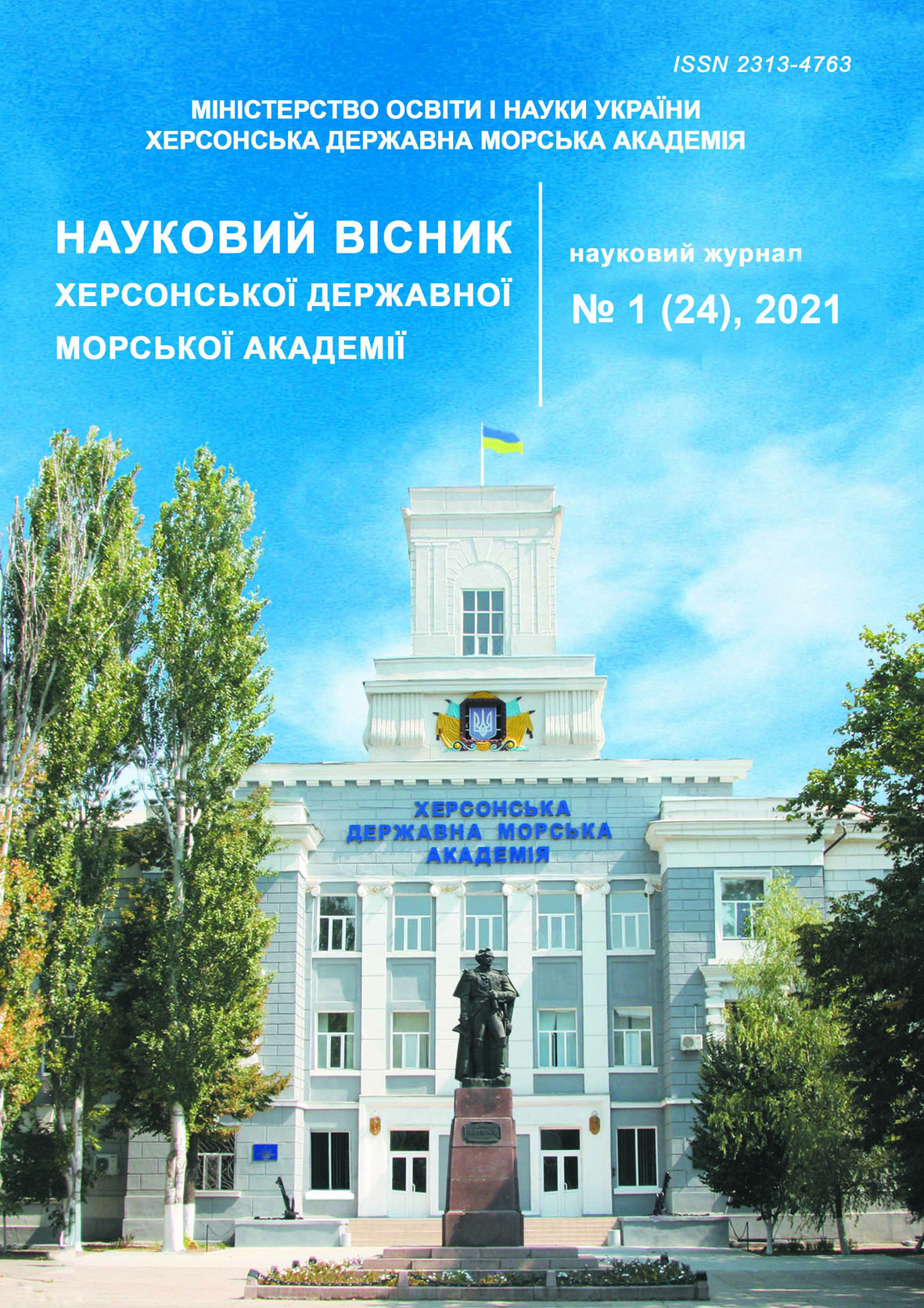INFLUENCE HUMAN FACTOR ON SAFETY’S PLANNING ROUTE OF WATER TRANSPORT
10.33815/2313-4763.2021.1.24.057–070
Abstract
The study is aimed at conducting a formal analysis of algorithms for captains to apply when planning routes in difficult navigation situations. Formal and algorithmic analysis based on decision trees made it possible to improve ergatic navigation safety systems and to predict potential risks of maritime accidents in a timely manner. The article discusses approaches enabling algorithmisization of processes of navigational situations perception by captains. A formal description of the most essential elements of captains’ human factor affecting the route planning processes is provided. Also, the issues related to perception of difficult navigation situations by captains are considered, dependences on volume and multithreading of input information are given. In order to confirm actual influence of captains’ human factor elements on safe route planning, a number of experiments have been carried out using the Navi Trainer 5000 navigation simulator and subsequent modeling by means of Data Mining. As a result of modeling, standard designs for planning water transport routes have been obtained together with the confirmation of constructed models adequacy exemplified by the factor Fs 3 - «weather conditions». The proposed approaches will further expand the capabilities of predictive possible maritime accidents models due to human factor.
References
2. Nosov P. S., Tonkonohyi V. M., Yakovenko O. Ye. (2006). Zastosuvannia adaptyvnykh funktsii dlia vplyvu na model znan studenta . Trudih Odesskogo politekhnicheskogo
universiteta. Odessa : ONPU. Vol.1 (25), 118–122.
3. Popovych I. S., Cherniavskyi V. V., Dudchenko S. V., Zinchenko S. M., Nosov P. S., Yevdokimova O. O., Burak O. O. & Mateichuk V. M. (2020). Experimental Research of Effective «The Ships Captain and the Pilot» Interaction Formation by Means of Training Technologies, 2020. Revista ESPACIOS, Vol. 41 (11).
4. Nosov P. S., Zinchenko S. M., Popovych I. S., Ben A. P., Nahrybelnyi Y. A., Mateichuk V. M. (2020). Diagnostic system of perception of navigation danger when implementation complicated maneuvers. Radio Electronics, Computer Science, Control. Vol. 1, 146-161. DOI: https://doi.org/10.15588/1607-3274-2020-1-15.
5. Nosov P., Zinchenko S., Popovych I., Safonov M., Palamarchuk I., Blakh V. (2020). Decision support during the vessel control at the time of negative manifestation of human factor. CEUR Workshop Proceedings, 2608, 12–26 .
6. Buldaev A. S. (1991). Control over oscillations in delayed systems for modeling of diseases. Math modeling. Vol. 3, Issue 6, 10–21.
7. Zinchenko S. M., Ben A. P., Nosov P. S., Popovich I. S., Mamenko P. P., Mateichuk V. M. (2020). Improving the Accuracy and Reliability of Automatic Vessel Moution Control System. Radio Electronics, Computer Science, Control. Vol. 2, 183–195. DOI: 10.15588/1607-3274-2020-2-19
8. Lupini M. Fraïssé limits in functional analysis. Advances in Mathematics. 2018. Vol. 338. P. 93–174. DOI: 10.1016/j.aim.2018.08.012.
9. Fujimoto K. (2012). Classes and truths in set theory. Annals of Pure and Applied Logic. Vol. 163 (11), P. 1484–1523. DOI: 10.1016/j.apal.2011.12.006.
10. Kastrisios C., Pilikou M. (2017). Nautical cartography competences and their effect to the realization of a worldwide Electronic Navigational Charts database, the performance of ECDIS and the fulfilment of IMO chart carriage requirements. Marine Policy. Vol. 75, P. 29–37. doi:10.1016/j.marpol.2016.10.007
11. Pengfei Chen, Yamin Huang, Junmin Mou, P.H.A.J.M. van Gelder. (2018). Ship collision candidate detection method: A velocity obstacle approach. Ocean Engineering. 170, 186–198. doi:10.1016/j.oceaneng.2018.10.023
12. Liu Yan, Frangopol Dan M. (2018). Probabilistic risk, sustainability, and utility associated with ship grounding hazard. Ocean Engineering. 154, 311–321. doi:10.1016/j.oceaneng. 2018.01.101
13. Nosov P. S., Cherniavskyi V. V., Zinchenko S. M., Popovych I. S., Nahrybelnyi Ya. A., Nosova H. V. (2021). Identification of marine emergency response of electronic navigation operator. Radio Electronics, Computer Science, Control. Vol. 1, 208–223. DOI:10.15588/1607-3274-2021-1-20
14. Nosov P., Ben A., Zinchenko S., Popovych I., Mateichuk V., Nosova H. (2020). Formal approaches to identify cadet fatigue factors by means of marine navigation simulators. CEUR Workshop Proceedings. 823–838.
15. Stepancov M. E. (2004). Matematicheskaya modelj napravlennogo dvizheniya gruppih lyudeyj. Matematicheskoe modelirovanie.
16. Nosov P. S., Popovych I. S., Cherniavskyi V. V., Zinchenko S. M., Prokopchuk Y. A., Makarchuk D. V. (2020). Automated identification of an operator anticipation on marine transport. Radio Electronics, Computer Science, Control. Vol. 3, 158172
17. Maling D. H. (1992). The Transverse Mercator projection. Coordinate Systems and Map Projections. Pergamon. 336–363. DOI:10.1016/B978-0-08-037233-4.50021-2
18. Zinchenko S. M., Nosov P. S., Mateichuk V. M., Mamenko P. P., Grosheva O. O. (2014). Use of navigation simulator for development and testing ship control systems. MNPK pamiati profesoriv Fomina Yu. Ya. i Semenova V. S. (FS – 2019), 350355.
19. Bole A., Wall A., Norris A. (2014). Navigation Techniques Using Radar and ARPA. Radar and ARPA Manual. Butterworth-Heinemann, 371–405, DOI:10.1016/B978-0-08-097752-2.00008-8
20. Al-Noor T. & Al-Obaidi, O. (2013). The course of lectures on Symmetry and group theory. University of Baghdad.
21. Glasner S. (1974). Topological dynamics and group theory. Trans. Amer. Math. Soc., Vol. 187, 327–334.
22. Malyutin A. (2020). Geometric group theory. Retrieved from https://www.lektorium.tv/node/32971.
23. Harris M. Speculations on the mod p representation theory of p-adic groups / M. Harris Annales de la faculté des sciences de Toulouse Mathématiques, 2016. Т. 25. Vol. 2–3. P. 403–418. DOI: 10.5802/afst.1499.
24. Kasianov V. Subjective entropy of preferences. Subjective analysis. Warsaw, Poland: Institute of aviation, 2013. 644 p.
25. Li Bo & Tian, Haonan & Yi, Huawei & Li, Xiaohui. (2020). Innovative Decision and Forecasting Approach on Navigation Risk. IEEE Access. 1-1. DOI: 10.1109/ACCESS.2020.3016720.
26. Hetherington C., Flin K. (2006). Safety in shipping: The human element. Mearns. Journal of safety research. Vol. 37, Is. 4, 401–411. DOI: 10.1016/j.jsr.2006.04.007.
27. Popovych I. S., Blynova O. Ye., Aleksieieva M. I., Nosov P. S., Zavatska N. Ye. &Smyrnova O. O. (2019). Research of Relationship between the Social Expectations and Professional Training of Lyceum Students studying in the Field of Shipbuilding. Revista ESPACIOS.Vol. 40 (33). 21 p.






